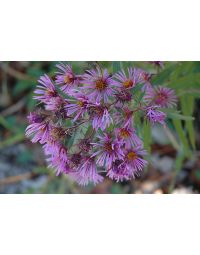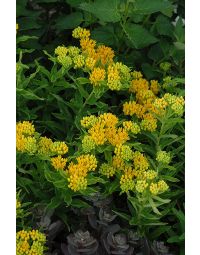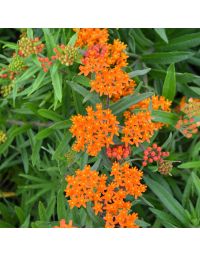The bane of many gardeners is dealing with clay soil. But does it have to be? Does clay have any redeeming value? Let's dig in.
Literally, it's not easy to dig in clay soil. It's heavy, sticky and a bit stubborn to work with. You can amend the soil to a certain extent, just don't expect miracles. Find those amendments further down in the article. Mostly, I choose to work with what I have and choose plants that naturally "thrive" in clay soil. You may be questioning my sanity right now but stick with me... no pun intended. It's the Master Gardener Mantra: Right Plant, Right Place.
Clay soil holds onto water like a champ. That's great during a drought, something we've endured more often than not. On the flip side is flooding. That means the clay soil holds too much water, which can result in slow growth and/or root rot. But here's a really interesting side to clay soil, it's jam-packed with essential nutrients!
New England Aster
Here's another plus, plants roots are held well in clay, it allows them to survive extremes of temperature and moisture, which means less heaving of newly planted plants. However (isn't there always a "however"?) do not walk on wet clay soil, ever. It will result in heavy compaction. Never plant when the soil is wet!
When dry, clay soil cracks and becomes rock-like, making it nearly impossible to plant in. Bottom line for planting in any soil is that it be "workable". In other words, you don't want to work so hard that your arms and/or legs are trembling when trying to dig a hole!
Adding organic matter (dried leaves & grasses, fully composted compost) is always a good idea no matter what type of soil you have. Now for the fun stuff, clay tolerant plants. Be sure to click on the name of the plants for a direct link!
Clay tolerant perennials:
- Daylilies offer loads of choices with differing bloom color, heights & bloom time
- Russian Sage adds a soft, airy texture
- Columbine - lovely in part shade areas
- Butterfly Weed - a native favorite of butterflies, bees & hummingbirds
- Liatris prefers full sun
- Sedum offers a large selection of choices
- Purple Coneflower - the native is awesome, but there are great cultivars too
- Black-eyed Susan - there's the Minnesota native and a number of cultivars, all of which are great for pollinators
- Monarda aka Bee Balm aka Bergamot prefers full sun and will deliver the bees
- New England aster - a super native that offers late blooming flowers for pollinators
- Clematis - an awesome vine with many choices
- Grasses include 'Karl Foerester' and 'Little Bluestem'
- Hardy Hibiscus emerges slowly, but, WOW, their late blooming flowers are worth the wait
- Ajuga is one tough ground cover that comes in cultivars
Daylilies
Flowering 'Karl Foerster' calamogrostis grass - the heads emerge green, then open to airy rosy-pink plumes in a sunny location
Clay tolerant shrubs:
- Aronia aka Chokeberry - part shade tolerant, cultivars in varying heights, berries & fall color too
- Diervilla aka Butterfly Bush - a great alternative to Burning Bush, yellow summer flowers that pollinators love & fabulous fall foliage
- Potentilla is a low shrub that flowers nearly nonstop from late spring to first hard frost
- Weigela is offered in a wide variety of flower color, leaf color & height. They love sun
- Lilacs can rock through cold winters! They're fragrant and not a favorite of deer or rabbits
- Carpet roses - give them full sun and they'll deliver flowers 3x a season. They also come in other colors
My 12 year old carpet roses deliver multiple times each season
The shrub in the middle is Diervilla 'Kodiak Orange' and the groundcover on the left bottom and in the upper middle is Ajuga 'Burgundy Glow'
Give aid to your clay soil be adding the amendments I mentioned above, such as fallen leaves, compost, peat moss and more. Don't expect miracles but it will make planting easier.
Embrace the clay,
The Garden Scoop



